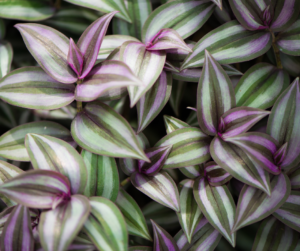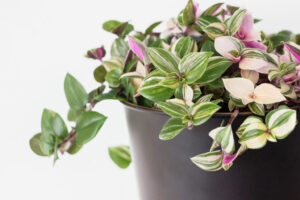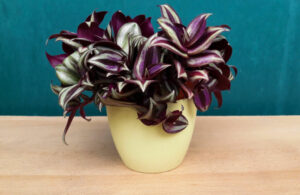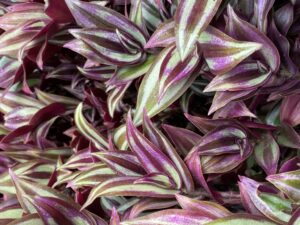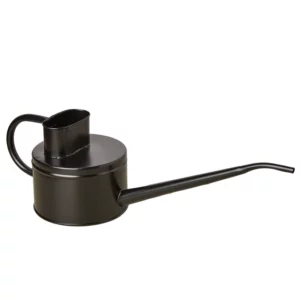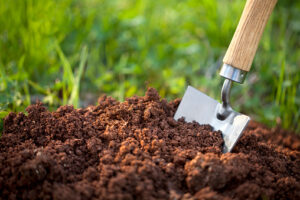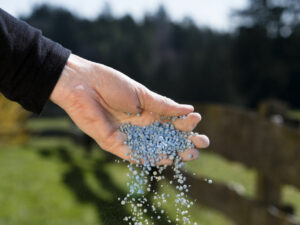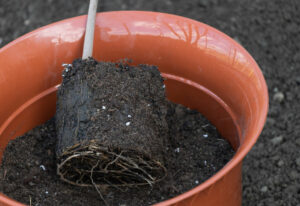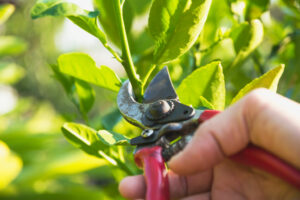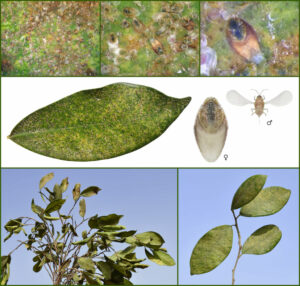HousePlantJoy is supported by our audience. When you purchase through one of our links, we may earn a small affiliate commission. As an Amazon Associate I earn from qualifying purchases. Your cost is not affected.
==================
Wandering Jew Houseplant Care and Tips
We consider the Wandering Jew Houseplant care quite easy to maintain. Once you meet the soil and watering needs, they grow and flourish for years.
When considering this plant, note that it is not a single type of plant but rather the name given to a few different plants in the genus Tradescantia. Although they need similar care, you might find the visual differences interesting.
When grown outdoors, these plants may become invasive. However, the steady growth rate and easy-care nature make this a great plant for indoor enjoyment.
Wandering Jew Overview
Wandering jew plants have green, heart-shaped leaves with purple stripes and a silvery sheen. Depending on the variety, the leaves can be solid or variegated. Blooms are small with three petals and can be violet or white.
Wandering jew is an inch plant with the scientific name of Tradescantia zebrina. It belongs to the family of Tradescantia fluminensis and first originated in Mexico. The wandering jew grows to 6 feet tall and requires bright light to indirect light. Watering the plant should be average to medium and requires 50-80 degrees Fahrenheit with an average humidity. The soil requirement of wandering jew is slightly moist with fertilizer.
There is a lot of variety of wandering jew, and each one demands different care, so keep reading to learn more about the wandering jew!
Types of Wandering Jew Plants
The name ‘wandering jew’ refers to three species in the Tradescantia genus: fluminensis, zebrina, and pallida.
========================================================
Tradescantia fluminensis
This is the classic wandering jew plant. It has dark-green leaves that contrast nicely against the bright, white, three-petaled flowers.
Tradescantia zebrina
As you can probably guess, it’s named for its zebra-like leaves. The middle of each half of the leaves is a creamy white, with the outer edges tipped in silver.
Tradescantia pallida
This variety is unique because the foliage is a deep purple with light purplish-pink flowers. It’s one of the most popular varieties of wandering jew.
Wandering Jew Houseplant Care
All types of Wandering Jew plants are fairly easy to care for. As long as you give them sufficient light and keep them pruned as needed, they will honor you with great beauty for many years.
Light
The Wandering Jew thrives in bright yet indirect sunlight. The brighter the light, the healthier and more brilliant your plant becomes. Also, the brighter light allows them to produce more flowers.
Conversely, in dimmer light, the foliage color fades. As such, your plant provides you with distinct clues as to the amount of light it needs. For instance, if the leaves lose the intensity and brightness of color, the plant begs for more light. Provide that light, and you will note the true, natural colors are emerging with the new growth.
In zones 9 through 11, you might keep some of your plants outdoors. Yes, the Wandering Jew grows well outdoors if you are in these warmer climates. It can be grown as a distinctive ground cover in these warmer climates.
And it is still possible to keep the plant outdoors in the summer months in the other zones, too. Just monitor the temperatures and bring the plant back inside when the temperature nears the low 50s.
Water
These plants thrive and grow well when watered regularly but not over-watered. Avoid soaking them too often, and do not allow them to dry out completely. Keep the soil evenly moist for the healthiest plants. Water when the top 1/2″ of soil feels dry. Then, water is thoroughly, but ensure it is draining well. These plants do not like soggy roots.
Soil
The best soil for a Wandering Jew Houseplant contains organic matter and drains quite well. A standard mix works, but you may improve it by adding some of the following in equal parts.
- Perlite or coarse sand
- Peat or humus
- Worm castings and/or rich, organic compost
- A light sprinkle of lime
You need the perfect balance of water absorption with good drainage. Therefore, after mixing, run water through the pot and watch for the results. Make your adjustments before adding the plant.
Fertilizer
Use a water-soluble fertilizer twice a month during the growing season. Most fertilizers are too strong for these houseplants. Dilute them to about 50% of the recommended strength. It’s better to fertilize more frequently with a dilute solution than to risk burning the roots or foliage. Using a slow-release fertilizer to the soil once a year also proves beneficial.
Repotting
A Wandering Jew in a cramped pot does not fare well. Over time, it will show signs of stress. And the vines become frail and leggy.
When it’s time to repot, select a pot at least a couple of inches wider than its current home. Prepare your pot with a little fresh potting soil around the sides. This is a good time to add a few stones to the bottom of the new pot to increase drainage.
Carefully remove the plant from its now too-small pot. Keep the root ball intact. Set the plant, including the root ball, into the new pot. Add new soil around the plant to set it into place. Fill the pot with more soil to about 2″ below the rim. Lightly tap down the soil to keep the plant securely in its new place.
Make sure you water the plant. Feeding at this time is a good idea, too.
Pruning
Wandering jew plants have a tendency to become quite leggy. Therefore, prune them as they grow to maintain a beautiful, healthy look. To prune, cut back the stems to a point where they are strong and healthy. Pinch off stem tips with your fingers or a good pruning shear. Watch these pruned areas for new growth. They usually send out two new shoots from the cut area, creating a bushier appearing plant.
Propagation
We recommend that you don’t waste your stem cuttings. Propagating the Wandering Jew makes an enjoyable hobby and allows you to share your plant with friends. To do this, remove all but a few leaves off of the stem cuttings. Place them in a smaller pot with moist potting soil. Keep it in a warm, bright area. You’ll start seeing new shoots growing within 1 to 2 months. The Wandering Jew plants propagate quite easily, giving you new additions or gifts to share.
However, when problems occur, consider changing your method slightly. If the cuttings rot before rooting, a fungal infection might be the cause. You’ll need just a couple of steps to prevent further problems. First, clean and sterilize your clipping tools. Bleach or a strong hydrogen peroxide solution creates a good sterilization bath for your cutters and other tools. Use it between each cut to ensure you don’t spread any disease.
Also, consider rooting your cuttings in water. Many gardeners find this works or is better than rooting in the soil. Again, use a clean container of fresh water. And change the water frequently, perhaps several times a week, to keep it fresh and free of harmful pathogens. When the roots show strong growth, plant them into a potting mix. For more information on propagating houseplants, see our techniques article.
Problems Incurred in Wandering Jew Houseplant Care
In some people and animals, skin irritation can occur when coming in contact with the sap from the plant. You should keep it in an area hard for children and pets to reach. Consider growing it in hanging baskets too high for your pets to nibble on. The Wandering Jew houseplant displays beautifully in a handling basket.
Pests
The most prominent pests you’ll deal with on wandering jew plants are spider mites. They love warm, dry areas, so one good way to counter them is to keep humidity high or mist your wandering jew plant. If that doesn’t work, you can wash the plant off with water to knock the mites off plant. For even more serious infestations, you should remove infected areas and use a systemic insecticide.
Diseases
Over-watering causes most diseases with Wandering Jew Houseplant Care. Root rot is a big problem with most houseplants. The cause usually comes from over-watering or soil that does not drain properly.
Thus, you avoid the problem easily. For over-watering, just water less often. The soil should dry very slightly on the top before adding more water.
If the problem is the soil mix, you may repot using a well-drained mix. Alternatively, add perlite or coarse sand to the existing mix. Also, adding rocks to the bottom of the pot under the soil improves drainage.
Conclusion
Now that you have an insight on how to grow a wandering jew try growing now! It can be a lot of work, especially if you are not used to it, but you’ll get the hang of it. Keep this article to be your guide on growing wandering jew. The care tips will keep you on track while growing this plant. So start now and tell us how or care tips helps you!


